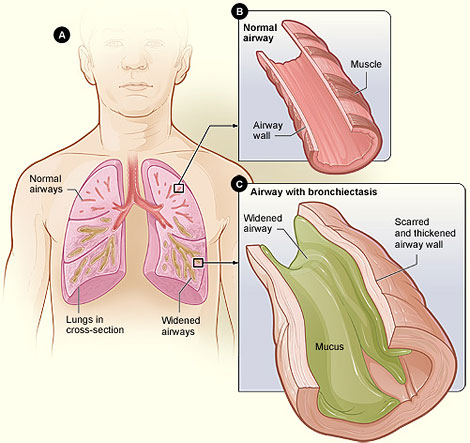What Is Bronchiectasis?
Bronchiectasis (brong-ke-EK-tah-sis) is a condition in which damage to the airways causes them to widen and become flabby and scarred. The airways are tubes that carry air in and out of your lungs.
Bronchiectasis often is caused by an infection or other condition that injures the walls of the airways or prevents the airways from clearing mucus. Mucus is a slimy substance. It helps remove inhaled dust, bacteria, and other small particles from the airways.
In bronchiectasis, your airways slowly lose their ability to clear out mucus. The mucus builds up, and bacteria begin to grow. This leads to repeated, serious lung infections.
Each infection causes more damage to the airways. Over time, the airways can't properly move air in and out of the lungs. As a result, the body's vital organs might not get enough oxygen.
Bronchiectasis can lead to serious health problems, such as respiratory failure, atelectasis (at-eh-LEK-tah-sis), and heart failure.
Bronchiectasis

Figure A shows a cross-section of the lungs with normal airways and widened airways. Figure B shows a cross-section of a normal airway. Figure C shows a cross-section of an airway with bronchiectasis.
Overview
Bronchiectasis can affect just one section of one of your lungs or many sections of both lungs.
The initial lung damage that leads to bronchiectasis often begins in childhood. However, symptoms may not occur until months or even years after you start having repeated lung infections.
In the United States, common childhood infections—such as whooping cough and measles—used to cause many cases of bronchiectasis. However, these causes are now less common because of vaccines and antibiotics.
Now bronchiectasis usually is due to a medical condition that injures the airway walls or prevents the airways from clearing mucus. Examples of such conditions include cystic fibrosis and primary ciliary (SIL-e-ar-e) dyskinesia (dis-kih-NE-ze-ah), or PCD.
Bronchiectasis that affects only one part of the lung may be caused by a blockage rather than a medical condition.
Bronchiectasis can be congenital (kon-JEN-ih-tal) or acquired. Congenital bronchiectasis affects infants and children. It's the result of a problem with how the lungs form in a fetus.
Acquired bronchiectasis occurs as a result of another condition or factor. This type of bronchiectasis can affect adults and older children. Acquired bronchiectasis is more common than the congenital type.
Outlook
Currently, bronchiectasis has no cure. However, with proper care, most people who have it can enjoy a good quality of life.
Early diagnosis and treatment of bronchiectasis are important. The sooner your doctor starts treating bronchiectasis and any underlying conditions, the better your chances of preventing further lung damage.
Clinical trials are research studies that explore whether a medical strategy, treatment, or device is safe and effective for humans. To find clinical trials that are currently underway for Bronchiectasis, visit www.clinicaltrials.gov.
The NHLBI updates Health Topics articles on a biennial cycle based on a thorough review of research findings and new literature. The articles also are updated as needed if important new research is published. The date on each Health Topics article reflects when the content was originally posted or last revised.















